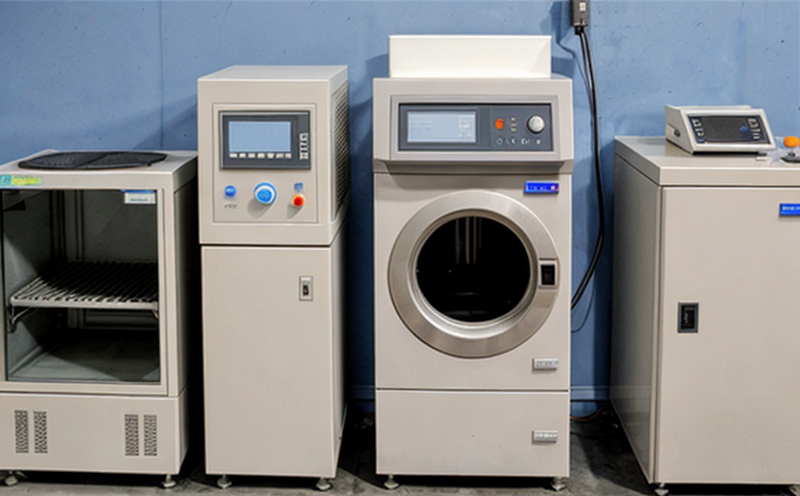ISO 16000 37 Indoor Airborne Dispersion of Nanomaterials
The ISO 16000 series of standards provides a comprehensive framework for the assessment and measurement of indoor air quality. Among these, ISO 16000-37:2018 specifically addresses the dispersion and solubility testing of nanomaterials in an indoor environment. This standard is pivotal for ensuring that nanomaterials used in products do not pose risks to human health or the environment.
The primary focus of ISO 16000-37 is on the release of airborne nanoparticles into indoor spaces, which can occur through various means such as product wear and tear, manufacturing processes, or direct application. The standard outlines methodologies for quantifying these nanoparticle emissions to assess their potential impact on air quality.
The testing protocol involves several steps, including sample preparation, instrument calibration, and the measurement of airborne nanomaterial concentration over time. Specimens are typically prepared by dispersing known quantities of nanomaterials in controlled environments that simulate real-world conditions. The dispersion process is critical as it mimics how nanoparticles might behave under various environmental stresses.
The standard specifies the use of advanced instrumentation such as scanning electron microscopy (SEM) and laser-induced incandescence (LII) to measure nanoparticle size, concentration, and distribution in air samples. These instruments are chosen for their precision and ability to differentiate between different types of nanoparticles based on physical properties.
One key aspect of ISO 16000-37 is the determination of solubility thresholds—levels above which nanomaterials become more bioavailable, potentially increasing their health risks. Solubility tests are conducted by exposing samples to standardized media and measuring the amount of dissolved material over time.
Another important consideration in this standard is the evaluation of particle size distribution, as smaller nanoparticles have greater potential for inhalation and deeper penetration into lung tissue. The standard recommends using a combination of laser diffraction instruments and scanning electron microscopes to accurately measure these distributions.
The results from ISO 16000-37 testing are essential for quality managers, compliance officers, R&D engineers, and procurement teams who need to ensure that their products meet stringent safety standards. By providing detailed data on nanoparticle dispersion and solubility, this standard helps manufacturers make informed decisions about material selection and process optimization.
The application of ISO 16000-37 extends beyond just regulatory compliance; it also supports sustainability initiatives by enabling companies to minimize their environmental footprint while maintaining product performance. For instance, understanding nanoparticle dispersion can help reduce the amount of volatile organic compounds (VOCs) released into indoor spaces, contributing positively to indoor air quality and worker health.
In summary, ISO 16000-37 is a vital tool for ensuring that nanomaterials used in products do not pose risks to human health or the environment. By providing precise methods for quantifying nanoparticle dispersion and solubility, it empowers stakeholders to make informed decisions that balance innovation with safety.
Why It Matters
The dispersion of nanomaterials into indoor air is a growing concern due to the unique properties of nanoparticles. Unlike larger particles, nanomaterials can remain suspended in the air for extended periods and are easily inhalable. This poses significant risks to human health, particularly when they accumulate in lung tissue.
- Health Risks: Nanoparticles smaller than 100 nm can penetrate deep into the lungs, potentially causing respiratory issues or other adverse effects.
- Environmental Impact: Unintended release of nanomaterials into the environment could disrupt ecosystems and affect biodiversity.
- Regulatory Compliance: Adhering to standards like ISO 16000-37 is crucial for maintaining compliance with international regulations, avoiding penalties, and safeguarding brand reputation.
The importance of this standard lies in its ability to provide a consistent methodology for assessing nanoparticle dispersion. By doing so, it helps ensure that products are safe for both consumers and the environment. This, in turn, fosters trust among stakeholders and supports long-term business sustainability.
Environmental and Sustainability Contributions
The testing outlined in ISO 16000-37 plays a crucial role in advancing environmental protection and promoting sustainable practices. By identifying and mitigating the risks associated with nanomaterial dispersion, this standard contributes to cleaner indoor air environments and safer working conditions.
Manufacturers who comply with these standards can reduce their carbon footprint by optimizing production processes to minimize nanoparticle emissions. Additionally, they contribute to broader environmental goals by supporting research into more sustainable materials and technologies.
The data generated from ISO 16000-37 testing also supports innovation in product design. Companies can use this information to develop safer, more environmentally friendly products that meet both current and future regulatory requirements. This not only enhances their competitive position but also aligns with global trends towards greener manufacturing practices.
In summary, ISO 16000-37 is an essential tool for promoting environmental stewardship and sustainability in nanotechnology applications. Its focus on reducing nanoparticle dispersion helps create healthier indoor environments while fostering responsible business practices.
Competitive Advantage and Market Impact
- Innovation Leadership: Compliance with ISO 16000-37 demonstrates a company's commitment to innovation and safety, setting it apart from competitors who may not prioritize these factors.
- Customer Trust: By ensuring product safety through rigorous testing, companies can build strong relationships with customers seeking reliable and eco-friendly solutions.
- Regulatory Compliance: Adherence to international standards helps avoid legal issues and maintains a positive reputation in the market.
- Market Access: Meeting these standards opens doors to global markets where stringent regulations are enforced, enhancing export opportunities for manufacturers.
The implementation of ISO 16000-37 also provides valuable insights that can be leveraged for continuous improvement. Companies can use this data to refine their manufacturing processes and product designs, ultimately leading to more efficient operations and increased market share.
Furthermore, the transparency provided by this standard encourages collaboration between industry stakeholders, academic institutions, and regulatory bodies. This collaborative approach fosters a culture of shared responsibility and innovation that benefits all parties involved in nanotechnology applications.





